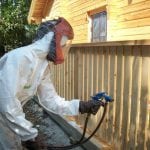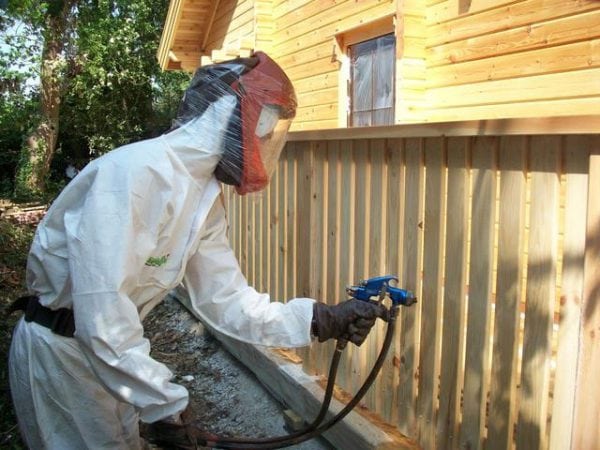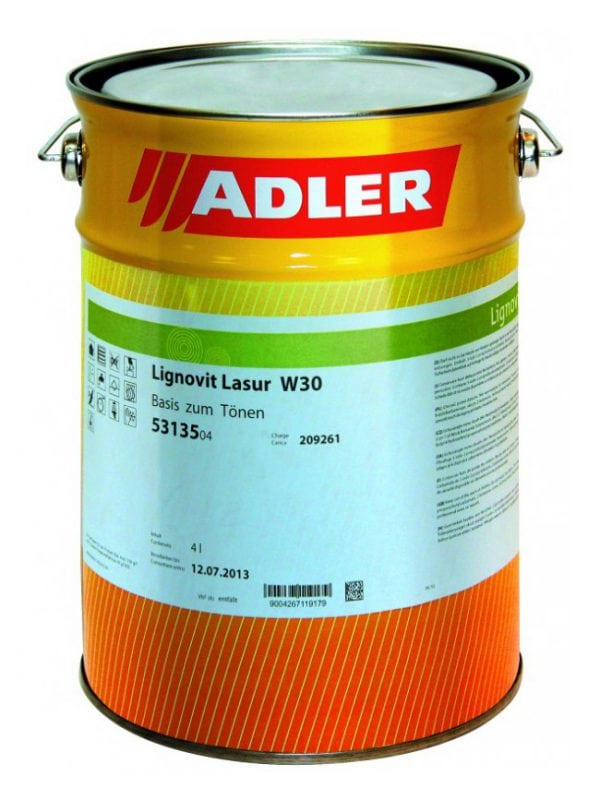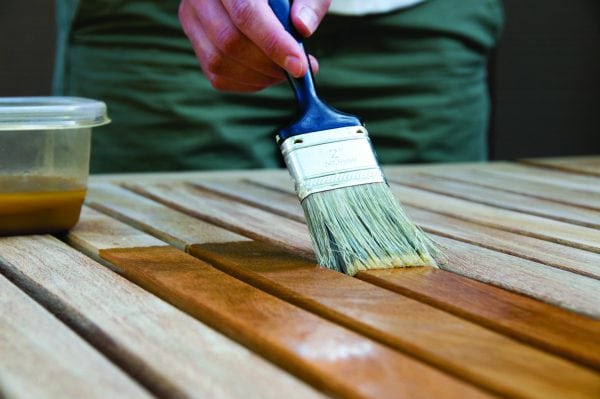Loved by mankind for its strength and natural beauty, wood is not only afraid of moisture and dampness - it is still very combustible. For centuries, people have been looking for how to protect their homes from fire, invented various solutions and techniques to minimize the combustibility of wood and reduce the damage from fire. For this purpose, various non-combustible substances were added to the construction compounds for the purpose of fire-retardant treatment of wood. Fire-resistant varnishes, paints and impregnations gradually appeared.
- How does fire protection work
- Varieties of mixtures
- Processing methods
- Degree of protection
- Self-protection of the building from fire

How does fire protection work
Protecting wood from fire is possible in two ways:
- Fire retardants, which include low-melting substances (salts of silicic, boric or phosphoric acid) melt when heated, forming a resistant film that does not allow air to pass to a wooden surface. Due to this, the ignition temperature of the tree is significantly increased, and hence its fire resistance.
- If the fire-fighting mixture contains ammonia or other similar preparations, then during a fire they emit gases that suppress the flame and push oxygen away from the surface of the wood.
Varieties of mixtures
All compositions, depending on the basis, can be divided into:
- Paints. They provide good protection by covering wood products with a dense and durable film. Cons: hide the beauty of the surface; toxic. It is good to use them for fire protection of old buildings.
- Lucky. They emphasize the beauty of the wooden surface, reliably protect it from fire, but are not suitable for internal work due to toxicity.
- Impregnation - used most often.
The latter need to dwell in more detail. Impregnations perfectly preserve the structure of the tree, penetrate deep into the material, protecting it from fire.
Depending on the solvent, there may be:
- organically soluble - often toxic, used for outdoor use.
- water-soluble - non-toxic, suitable for processing walls inside and out.
Water-soluble impregnations are divided into:
- Easily washable. They are used in dry and moderately humid indoor areas, are well suited for living rooms, provide good protection in case of fire.
- Washed away. They are used for processing living rooms and utility rooms with moderate humidity, they protect wood well from fire.
- Difficult to wash. Suitable for wet rooms (kitchen, bathroom) and for outdoor use.
- Leave-in formulations with enhanced fire retardant function. Well suited for outdoor and indoor baths, saunas and other fire hazardous facilities.
Processing methods
Impregnation of wooden fire protection products can be of various depths:
- Superficial. As a rule, it is carried out at already finished facilities. The composition is applied to a well-cleaned and fat-free surface with a brush, roller or spray, left to dry, and then the rest of the decorative woodwork is carried out. Fire resistance is moderate.
- Moderate. It is carried out by soaking in special baths, it is carried out during the construction process. Provides good fire protection to the building.
- Deep using an autoclave.Such impregnation is possible only in an industrial way, when the composition is pressed under pressure deep into the pores of the wood. The resulting board has high fire-retardant qualities and does not need subsequent processing with protective agents.
When choosing a method and solution for processing, it should be borne in mind that the deeper the composition penetrates the base of the tree, the higher its resistance to fire. If it is possible to use wood processed by the autoclave method for construction, then it is better to build from it.
Degree of protection
According to fire safety standards, the degree of protection of wood from fire can be:
- Maximum, in the first class. Such fire protection is inherent in wood after autoclaving. Buildings made of such material can not catch fire under the influence of fire for up to 150 minutes.
- Secondary grade average. Treated wood becomes flammable, able to resist flame for up to 90 minutes. Such stability is achieved by soaking the boards before construction in a bath with a flame retardant.
- Low, in the third grade. This is achieved by surface treatment of buildings with solutions, typical of private residential buildings.
Self-protection of the building from fire
Unfortunately, it is impossible to give the finished building the first and second class of fire protection against fire. But the composition selected depending on the purpose will significantly reduce the fire hazard. When choosing an impregnation, it is necessary to consider:
- Heated premises. For attics, verandas, as well as for outdoor work, frost-resistant compounds must be taken.
- The influence of atmospheric factors. For the street you need difficult to wash mixture.
- Environmental friendliness. For homes, only non-toxic drugs are suitable, and when working with toxic ones, protective equipment must be used.
- Aesthetics. As a rule, impregnating agents do not affect the color and texture of the tree.
- Profitability.
- Fire safety. In the instructions for use, the protective degree of the drug should be indicated.
- Sustainability. How much time should pass before further processing.
It is easy to apply flame retardants on a wooden surface. It is carried out in the same way as when using other types of impregnation:
- All impregnation work is carried out at a positive temperature in calm weather or in a well-ventilated area. Working at low temperatures will reduce the absorbent quality of the wood surface and reduce the protective properties of the solution.
- Boards are cleaned of old paint, dirt and dust.
- If possible, degrease with white spirit.
- The solution is evenly applied to the prepared area with a brush, roller or spray gun.
- The surface is dried and the final decorative and construction work is carried out.
Tip: the flame retardant qualities of the treatment can be checked independently. To do this, from different places of the wooden structure, you need to take small slivers and hold them above the flame.
Without constant exposure to fire, the sliver should go out. Carrying out fireproof impregnation of buildings is a responsible process that should not be neglected during construction or cosmetic repairs.
Proper application of flame retardants on wooden surfaces will increase the safety of a residential building. But it is worth remembering that even the highest quality drugs applied by the surface method, after a couple of years under the influence of atmospheric phenomena, reduce their protective properties. Repeated application will be required.






